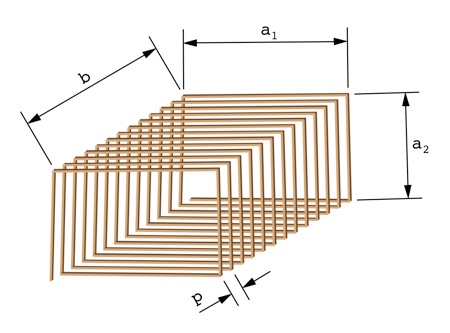Use this calculator to find the inductance of a single layer rectangular coil. Refer to the following diagram for the definition of the input variables.

For circular coils refer to the Solenoid Inductance Calculator Page. For other types of coils, see the Downloads Page for calculators in spreadsheet form.
Note: This formula is suitable for both long and short rectangular coils, and will accurately calculate the inductance of rectangular loop antennas.
Scroll down for detailed information and instructions.
Principal dimensions (coil length b, coil cross section width/height a1,a2) are measured from centre to centre of the wire. Pitch p is centre to centre spacing between windings. The units for all dimensions, except conductor diameter, are according to the pop up menu at the top of the calculator. The conductor diameter is either mm or AWG according to the units pop op adjacent to the conductor size input field.
For multi-turn coils, you may enter either the coil length or the winding pitch. Select the either Pitch or Coil Length from the pop up menu, and then enter the corresponding p or b value into the input field. For single turn coils, you can leave this field blank.
A field is provided for you to enter the overall wire diameter which includes the insulation thickness. This field is optional, but makes it convenient to specify close wound coils. To do this, leave the Winding Pitch/Coil Length field blank or set to zero, and enter the overall wire diameter into the di field. (You still need to enter the conductor diameter.) When you click the Calculate button, the pitch and coil length will be adjusted to appropriate values for a close wound coil. In addition, if you enter a conductor size d or overall wire diameter di that is too large for the specified pitch or coil length, the pitch and coil length will be increased automatically to the close wound dimension. If you are using standard enamelled magnet wire, you can check the Auto Calculate box, and the overall diameter for this type of wire will be calculated automatically, based on the conductor size. Calculation of enamel thickness is based on typical magnet wire used by hobbyists, and may vary slightly from the actual value due to different insulation temperature ratings which affects insulation thickness.
When entering conductor size as AWG, sizes larger than 0 may be entered as 00, 000, etc., or 2/0, 3/0, etc. Although AWG sizes larger than 4/0 do not officially exist, the calculator will accept them and handle them according to the AWG standard ratio between successive sizes of 1.1229322.
Multi-turn coils use Niwa's 1924 general formula for rectangular current sheet inductance. Base Inductance is the value calculated from this formula. For single turn coils, formula #58 from F.W. Grover's Inductance Calculations - Working Formulas and Tables, is used.
Corrected Inductance is the Current Sheet Inductance value with corrections for round wire and frequency included. Round wire corrections are not required for single turn coils.
KS is Rosa's round wire self inductance correction.
KM is Rosa's round wire mutual inductance correction.
LI is frequency correction due to skin effect only. Copper wire is assumed. No correction for proximity effect has been applied in this calculation.
KM and LI are calculated using David Knight's fitted formulae.
Conductor diameter shown in the output data is the same as the Conductor Size input converted to the chosen units.
Calculated Wire Length is the total length of wire required to wind the coil, and accounts for wire pitch.
Revised 2023-01-29 in conjunction with major site revision.
Back to:
Calculators
Radio Theory
Home
This page last updated: January 29, 2023
Copyright 2010, 2023 Robert Weaver